This Pesto Without Pine Nuts recipe is made with walnuts instead of pine nuts for an easy, convenient, and inexpensive pesto sauce you can enjoy all summer long. Ready in just 10 minutes and made with only 7 ingredients, you'll love the pop of flavor this basil walnut pesto adds to all of your favorite dishes. Nut-free options are included in the recipe card.

Pesto is a classic Italian sauce made with fresh basil, garlic, parmesan cheese, olive oil, and pine nuts.
However, pine nuts can be an expensive and hard-to-find ingredient. Additionally, those with nut allergies may have to look for alternatives to traditional pine nut pesto.
But, the good news is that it is possible to make a delicious pesto without pine nuts.
In this post, we'll explore some alternative ingredients for pine nuts in pesto and provide you with a step-by-step guide on how to make pesto without pine nuts.
So, whether you just want to switch things up or you're looking for a homemade nut-free pesto option, this guide will give you all the tips and tricks you need to make a flavorful basil walnut pesto.
Disclaimer: Some links throughout this post are affiliate links. As an Amazon Associate, I earn from qualifying purchases. You can learn more by visiting my Affiliate Disclosure Page.
What is Pesto?
Pesto is a delicious Italian sauce that's made by blending together fresh basil, garlic, pine nuts, olive oil, and parmesan cheese. It tastes amazing on just about everything, including bread, pasta, pizza, meat, and seafood.
You can buy pesto from the store, but making it yourself is even better! It's really simple and lets you customize it exactly how you want it.
What Can I Substitute For Pine Nuts In Pesto?
Whether you ran out of pine nuts, can't find them at the store, or just want to make a nut-free pesto, there are a variety of substitutions for pine nuts in pesto. Here are a few of my favorites:
- Walnuts- The substitution this pesto recipe without pine nuts uses, and the substitution I use most often is walnuts. Walnuts have a similar texture and flavor as pine nuts so they make a fantastic substitute.
- Almonds- Another nut substitute that works well in pesto. Almonds are slightly harder textured and sweeter flavored compared to pine nuts. However, they still make a lovely pesto sauce.
- Sunflower Seeds- For nut-free pesto, sunflower seeds are a great option. They have a similar texture and flavor as pine nuts and are often less expensive.
- Pumpkin Seeds- Another nut-free option, pumpkin seeds have a slightly earthy flavor that works well in pesto.
- Cashews- Cashews have a creamy texture that can give pesto a unique flavor. However, they are typically more expensive than other nut substitutes.

Why You'll Love This Recipe
- No Pine Nuts- Traditional pesto is made with pine nuts, but they can be expensive and hard to find. Walnuts are a great pine nut substitute in basil pesto.
- Homemade- Making pesto at home only takes a few minutes and it's way tastier than the jarred pesto you buy at the store. And if you have extra basil in your garden this summer, making pesto is a perfect way to use it up!
- Ready in 10 Minutes- This recipe requires no cooking. Just toss all of the ingredients in a food processor or blender and you're on your way to an easy, homemade walnut pesto sauce.
- Customizable- I kept this pesto without pine nuts recipe simple, but it can easily be customized to fit your taste preferences. Add some sun-dried tomatoes, roasted garlic, or spinach for a twist on classic pesto.
Ingredient Notes
Here are some notes on the key ingredients. For the full list of ingredients, check out the recipe card below.
- Basil- You need fresh basil leaves to make pesto. For this recipe, you should aim for around 2 cups fresh basil leaves that are loosely packed, or roughly 2-3 ounces by weight
- Parmesan Cheese- To achieve the best flavor, I recommend grating fresh parmesan cheese from a block instead of using pre-grated cheese.
- Walnuts- When making pesto, I usually opt for walnuts as they're cheaper and more commonly available compared to pine nuts.
- Garlic- To prevent large chunks of garlic in your pesto, make sure to mince the garlic cloves before adding them to the food processor.
- Extra Virgin Olive Oil- Extra virgin olive oil is the ideal oil to use when making homemade pesto.
🌱 Sustainability Tip: Regardless of whether you have an outdoor garden or just a sunny windowsill in your kitchen, growing your own basil is easy. By doing so, you can reduce your carbon footprint since it lessens the distance your food needs to travel.

Substitutions and Variations
Here are a few ways you can try customizing this basil pesto without pine nuts recipe to fit your diet and taste preferences.
Substitutions
- Basil- Consider replacing some or all of the basil with alternative leafy greens, such as spinach, kale, arugula, parsley, beet greens, or carrot tops.
- Parmesan Cheese- You can substitute the parmesan cheese with pecorino romano cheese, asiago cheese, or nutritional yeast. Another option is to skip the cheese entirely and add a handful of extra walnuts instead.
- Walnuts- Experiment with other nuts and seeds like raw pumpkin seeds, sunflower seeds, pistachios, or almonds. You can also make a nut and seed-free pesto by excluding them altogether.
- Garlic- Substitute the fresh garlic with ½ teaspoon of garlic powder. Another option is to use garlic-infused olive oil instead of regular olive oil and fresh garlic.
- Extra Virgin Olive Oil- While extra virgin olive oil is the preferred oil for pesto, in a pinch, you can substitute it with light olive oil, avocado oil, sunflower oil, walnut oil, or canola oil.
Variations
- Nut-Free- If you want to make a nut-free pesto recipe, replace the walnuts with an extra ¼ cup of grated parmesan cheese.
- Dairy-Free- For a dairy-free pesto, use more walnuts, vegan parmesan cheese, or nutritional yeast in place of the traditional parmesan cheese.
- Gluten-Free- Basil walnut pesto is naturally gluten-free.
- Sun-Dried Tomato- To add a rich and tangy flavor to your pesto, try mixing in some sun-dried tomatoes.
- Roasted Garlic- Toss in a few cloves of roasted garlic for a richer, more complex garlic flavor.
- Spicy- To give your walnut pesto a spicy kick, add a few shakes of red pepper flakes.
Try it toasted! Toasting the walnuts before adding them to the pesto will add extra flavor to the sauce.

Equipment Notes
Here are some notes on any special equipment I used to make this recipe.
- Food Processor- Using a food processor to make homemade pesto makes it so quick and easy. While I personally use and love my KitchenAid 7-Cup Food Processor, you can also use a smaller food processor or even a blender to make this recipe.
How to Make Basil Walnut Pesto
Here is how to make this homemade pesto without pine nuts recipe.
Step 1: Pulse ingredients in food processor. Add the basil leaves, parmesan cheese, walnuts, garlic, kosher salt, and black pepper to the bowl of a food processor. Pulse a few times until all of the ingredients are coarsely chopped, scraping down the sides as necessary.
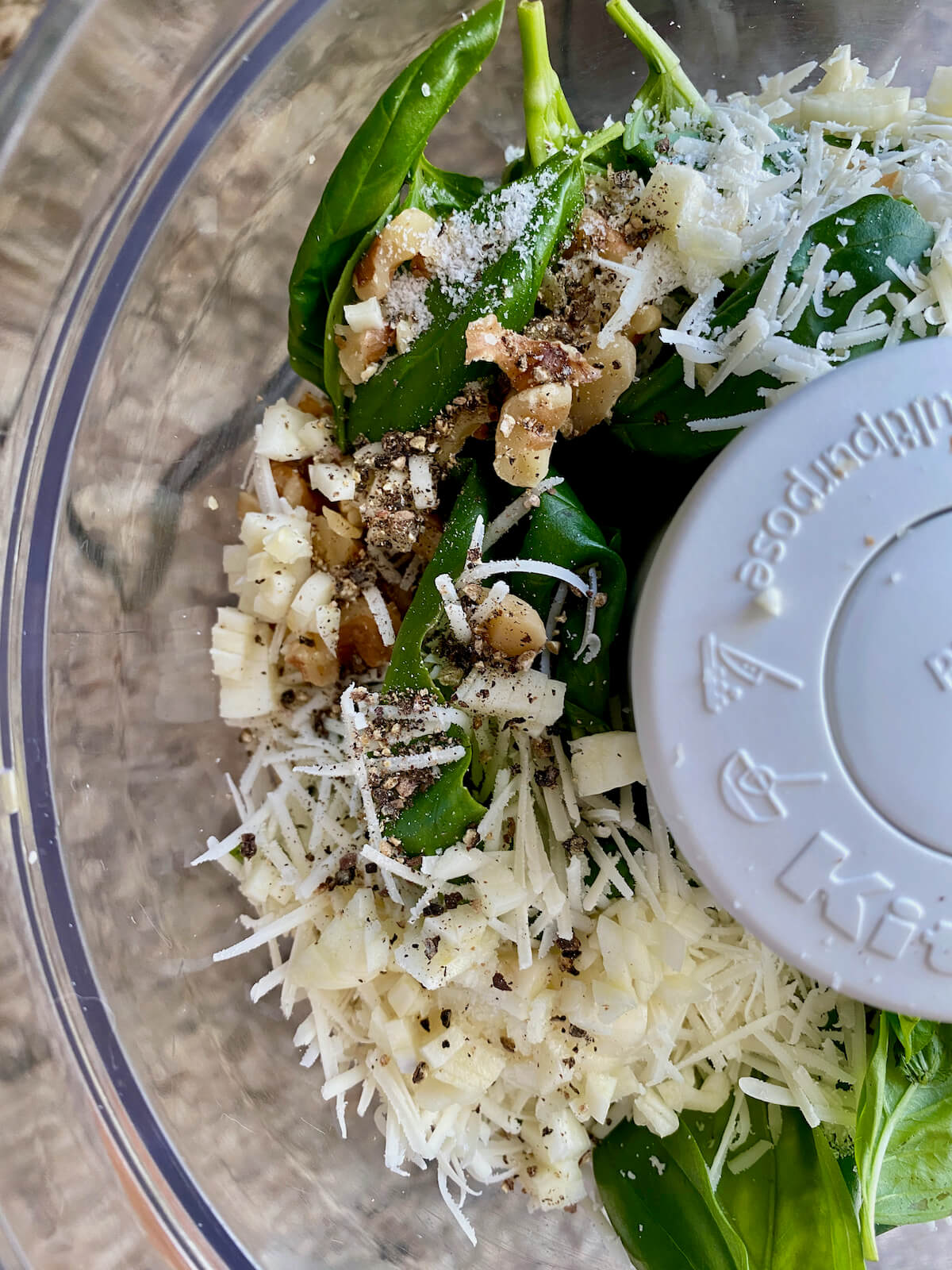

Step 2: Add olive oil. With the food processor running on low speed, slowly drizzle in the olive oil until the pesto sauce is creamy and emulsified. Be careful not to over-mix the pesto or it may taste slightly bitter. Serve immediately or refrigerate for up to one week.
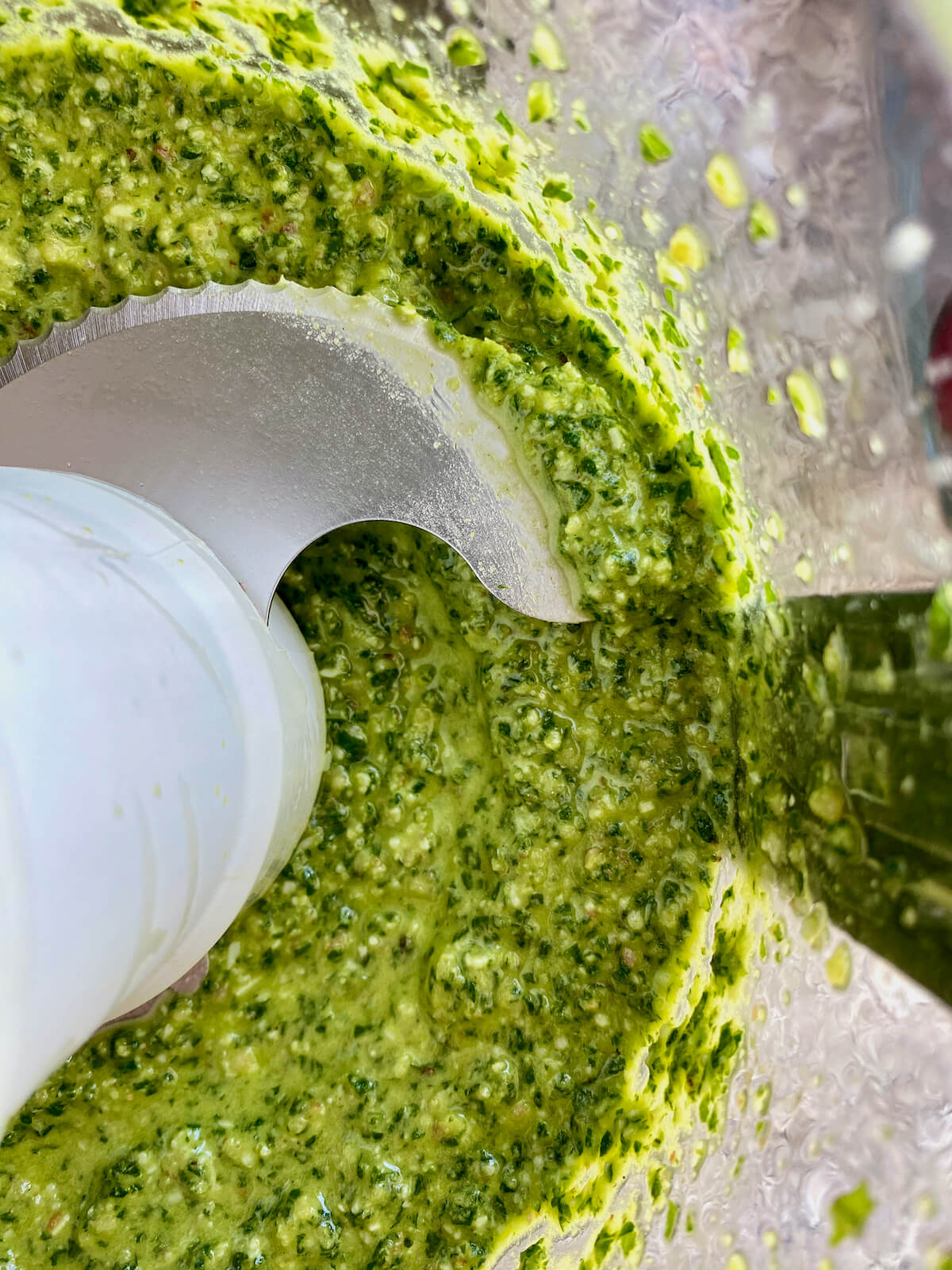
Tips for Success
- Use fresh ingredients. Fresh basil leaves, freshly grated parmesan cheese, fresh garlic, and high-quality extra virgin olive oil are essential for a delicious basil walnut pesto.
- Add the olive oil gradually. Add the olive oil to the food processor gradually and process on low until well combined. This will ensure an emulsified, creamy texture and prevent over-mixing.
- Don't over-mix the pesto. Homemade basil walnut pesto should have a creamy texture with some roughness to it. Be careful not to over-blend the pesto, as this can cause bitterness.
- Adjust for consistency. If the pesto is too thick, add more olive oil. If it's too thin, add more nuts or cheese.
How to Use Pesto Without Pine Nuts
Pesto without pine nuts is a flavorful and versatile sauce that pairs well with a variety of meats, seafood, pasta, and vegetables. Some of my favorite dishes to add this creamy pesto sauce without pine nuts to include Pesto Butter Salmon, Pesto Rigatoni, and Caprese Orzo Pesto Salad.
Alternatively, turn this easy walnut pesto into Homemade Pesto Butter - a delicious compound butter that can be used in all of your favorite savory dishes.
Other tasty ways to use this basil walnut pesto include:
- Sandwich spread
- Bread and cracker dip
- Pizza or baked potato topping
- Mixed into soup or risotto
- Tossed with vegetables
- Meat marinade- try it with grilled chicken, steak tips, or shrimp
- Mixed with scrambled eggs

Storage
How to Store
- Refrigerator- Store leftover pesto in an airtight container in the refrigerator for 5-7 days.
- Freezer- Freeze pesto in a freezer-safe plastic bag or container for up to 6 months. Try freezing the pesto in ice cube trays before transferring it to a bag for easier portioning.
Make Ahead
Prepare the pesto and store it in the refrigerator for up to one week before using it. Alternatively, store homemade no pine nut pesto in the freezer for up to 6 months.

Frequently Asked Questions
Pesto is typically made with basil, pine nuts, garlic, parmesan cheese, olive oil, salt, and pepper. For this pesto without pine nuts recipe, I use walnuts in the pesto because they're less expensive and easier to find than pine nuts.
Yes, quickly rinse your basil leaves under cold, running water before adding them to your pesto. Then, pat them dry and add them to the bowl of the food processor. Washing basil leaves ensures no dirt or bugs end up in your homemade pesto sauce.
There may be a few reasons why your pesto turned out bitter. Over-mixing the pesto sauce in the food processor can sometimes lead to a bitter taste. Alternatively, olive oil or walnuts that are past their prime may have a rancid, bitter flavor.
I always recommend consulting your doctor before eating any food you may be allergic to. However, you can use sunflower seeds and pumpkin seeds as tree nut-free substitutes for pine nuts in pesto.
Let's Connect!
Be sure to leave a comment below if you have any questions. You can also connect with me on Instagram, Facebook, Pinterest, or via email at [email protected].
📖 Recipe
Pesto Without Pine Nuts
Equipment
Ingredients
- 2 cup fresh basil leaves loosely packed
- ½ cup parmesan cheese freshly grated
- ¼ cup walnuts chopped (see notes for nut-free options)*
- 2 cloves garlic minced
- ¼ teaspoon kosher salt
- ¼ teaspoon black pepper
- ½ cup extra virgin olive oil
Instructions
- Add the basil leaves, parmesan cheese, walnuts, garlic, kosher salt, and black pepper to the bowl of a food processor. Pulse a few times until all of the ingredients are coarsely chopped, scraping down the sides as necessary.
- With the food processor running on low speed, slowly drizzle in the olive oil until the pesto sauce is creamy and emulsified. Be careful not to over-mix the pesto or it may taste slightly bitter. Serve immediately or refrigerate for up to one week.
Notes
- Nut-Free Options: Substitute walnuts with a ¼ cup of sunflower seeds, pumpkin seeds, or extra parmesan cheese.
- Quick Tip: If the pesto is too thick, add more olive oil. If it's too thin, add more nuts or cheese.
- Storage: Store leftover pesto in an airtight container in the refrigerator for up to one week or in the freezer for up to 3 months.

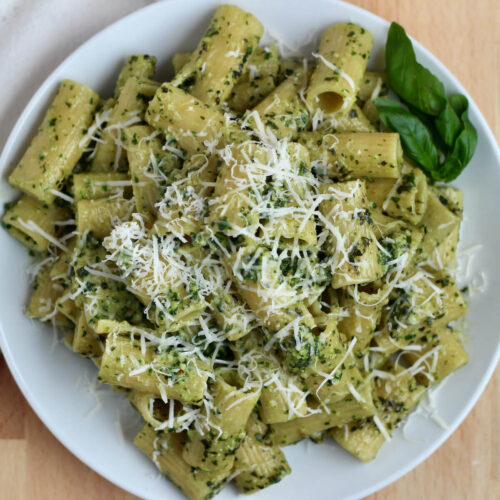

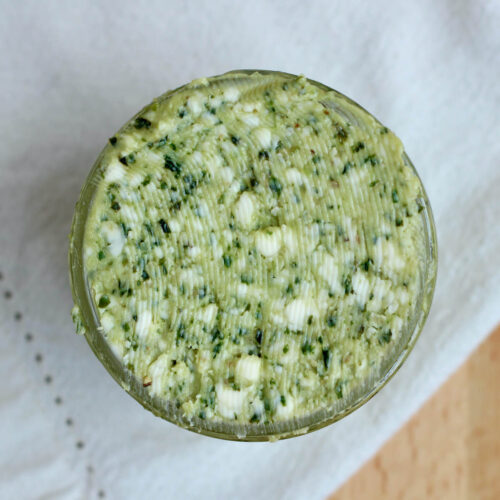

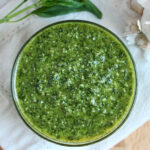


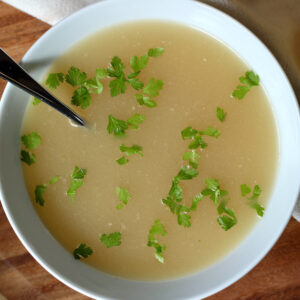

Comments
No Comments